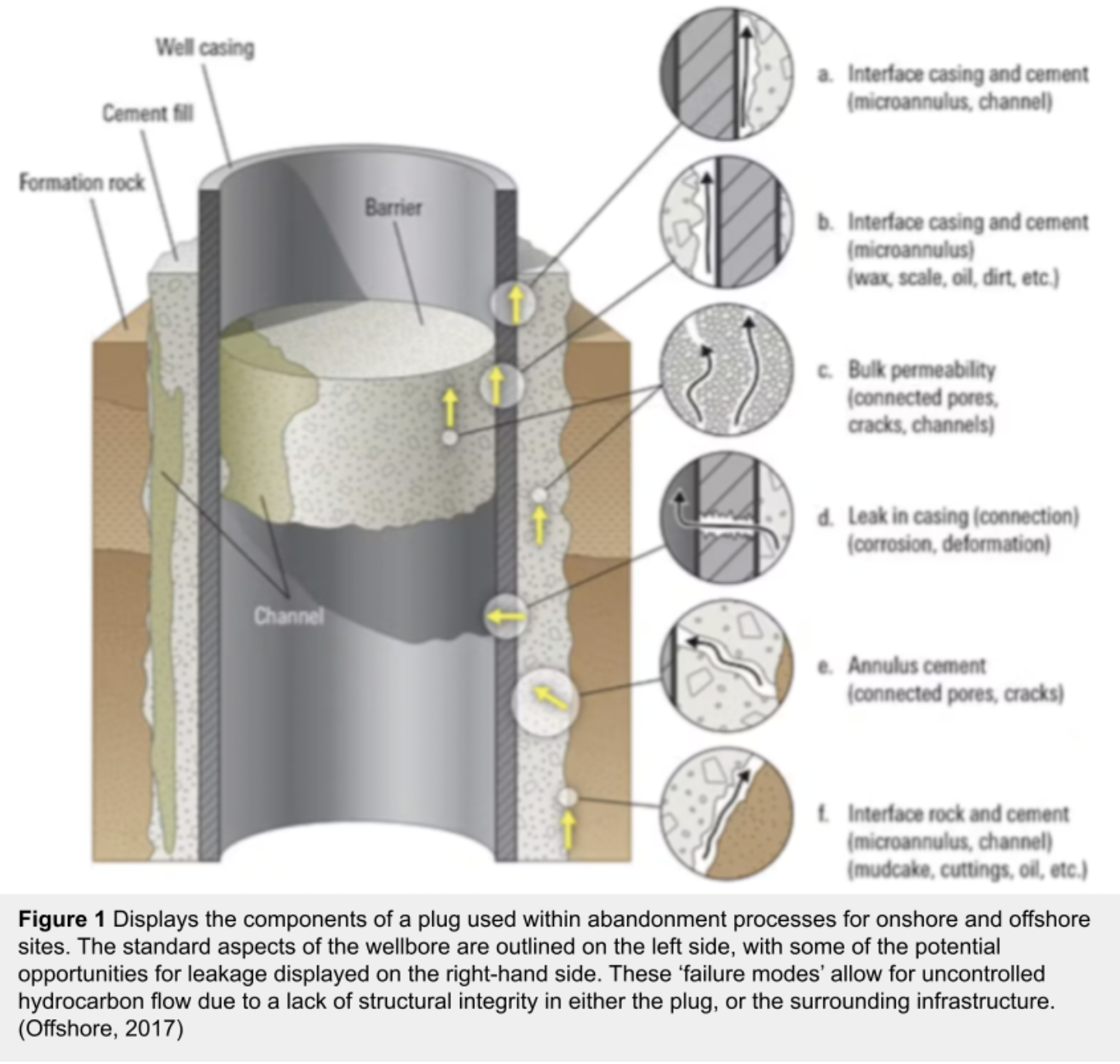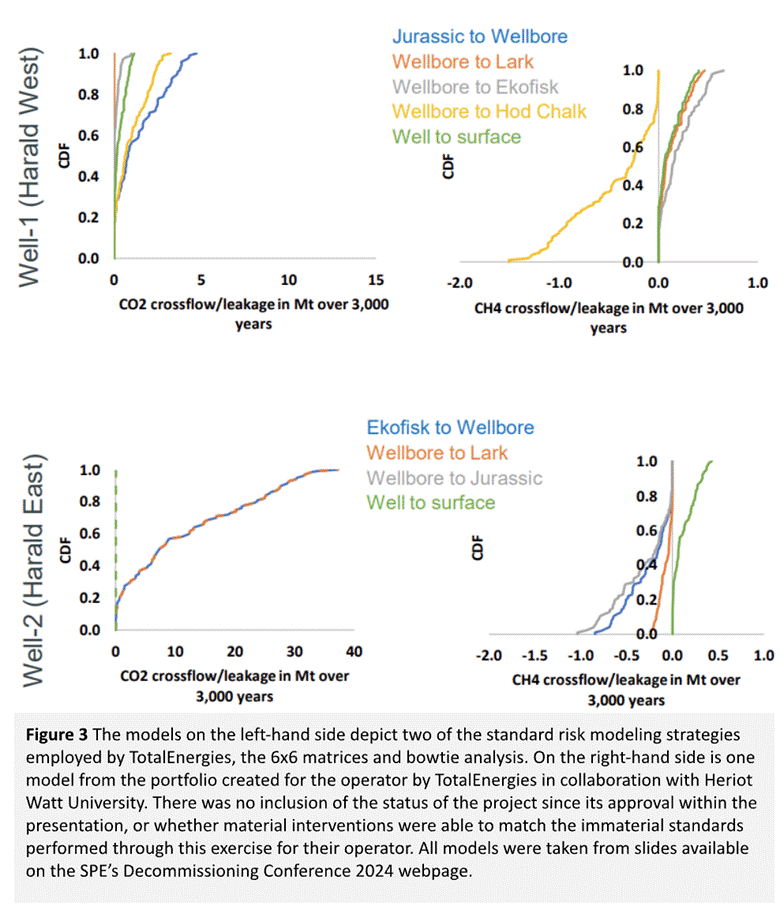By Ava Rawson
Infrastructure cannot be made safe for eternity. The post-life of oil and gas infrastructure provides an understudied frame of reference within the social sciences for the conceptual undertaking of how to realise safety across large time scales. When considering the material limits of technology used to decommission hydrocarbon infrastructure, we must widen our conceptualisation of oil related disasters, spills, and leakages beyond our present status-quo into a wider frame of temporal consequences. This blog post is centred on an excavation of the tension between the longevity of the offshore oil and gas extraction sites and the fallible material interventions created to prevent post-life disasters.
Within Part I of this blog post series, an exploration of the socio-political work underlying the decision to decommission an oil rig revealed the tension between the infrastructure’s immobile material form and its hypermobile contractual form within the oil and gas industry. Within Part II, I will first outline how post-life disasters are made materially possible through decommissioning. Then I will discuss how oil’s materiality within decommissioning is conceptualised, dealt with, and endeavoured to be controlled through its technological and mathematical depictions in models. This analysis reveals the work necessary in the creation of the future by oil and gas stakeholders through intelligently designed models, and the material consequences such depictions have.
Safety for Eternity

Following the cessation of production, the commencement of plugging and abandonment (P&A) procedures suggest a straightforward process for the permanent sealing of post-extractive sites. Cement is the most common sealant used within the plugging of wellbores, with the implementation of bismuth-alloy plugs also on the rise. Despite associations of fixity, the concrete and novel bismuth alloy compounds used within plugs (seen in Figure 1) for the decommissioning of hydrocarbon sites naturally ‘creep’ inwards, condensing over millennia. This inwards ‘creep’ of the plugs creates space for hydrocarbon leakage. Oil and gas regulators and stakeholders within the industry estimate that leakages resulting from degraded plugs will occur anywhere between three to ten thousand years from their insertion. Therefore, the stoppage of hydrocarbon flow they provide is temporary; there is no truly permanent solution. An interlocutor describing the ability of offshore oil and gas infrastructure to be made safe indefinitely stated that:
You can’t do it. A building that is onshore or offshore has a finite life.
I’ve worked for the department of energy and was responsible for the initial investigation of the Piper Alpha disaster…167 people were killed and the entire platform disappeared over the side. They never recovered all of the bodies, and as a result, the area around the pipeline has always been a no-go area from a grace point of view. I know it’s macabre but that’s probably the way to go with these platforms.
Break them up on site, let them fall to the sea…They are out of sight, out of mind, and it’s the cheapest way of doing it.
Our conceptualisation of oil related disasters, spills, and leakages are often limited to a popular experience of them, such as the Piper Alpha disaster of 1988. The ecological consequences of letting such infrastructure presently ‘fall to the sea’, is beyond the scope of this blog post. Instead, I shall focus on the concerns over how this statement situates the consequences of marine extractivism, and decommissioning, are perceived, as well as who benefits from such constructions. Future leakage and risk-based scenarios for sites to be plugged and abandoned are presented to decision-making stakeholders through models. I suggest that such projections can be understood not only as attempts at understanding the future, but are active engagements in the creation of a recognisable and predictable future for oil and gas stakeholders.
Quantitative Characterisations: Creating the Image of Oil
Often invisible to the naked eye, our ability to perceive oil, and simultaneously establish its value occurs though the substance’s prospecting phase. This is where geospatial engineering, seismic data, and advanced modelling both literally and socially create oil as a resource. Further refined through large scale industrial processes, oil is transformed into consumable energy, becoming socially fixed with connotations of energy security and power within the global market.
If the constructed properties of oil as a resource are in part socially established through the use of the technology deemed necessary to extract it, how is the rig actualised within such a value system when there is no more oil left to extract? Similar to the use of models within performances of speculation for oil and gas fields, social acceptance concerning the safety of plugged wells is determined through the performance of modelling and data visualisations.

The case study (Figure 2) presented at the Society of Petroleum Engineers’ (SPE) Decommissioning Conference, shared the presenters’ efforts in successfully securing a contract for a decommissioning and carbon storage project with a North Sea operator. Prior to the project’s approval, the application put forward by TotalEnergies (previously Total Gas & Power) was denied. The presenters’ clients (unnamed in the report) specifically requested additional models, as the visualisations failed to convince the operator of the project’s ‘safety’. This threshold of safety refers both to the material conditions of the project, as well as the safety of the client’s investment through its actualisation.
After TotalEnergies’s initial failure, new models were developed displaying probabilistic assessments of leakage and crossflow risks (Figure 2), as well as alternative scenarios such as natural recharge vs carbon storage. Through such modelling, the team credited themselves as being able to ‘analyse [the] impact of uncertain parameters’. This conclusion highlights that they believe models are capable of revealing a ‘truth’ about the future which was otherwise unknown to stakeholders before.


Models were coupled with full feedback loops, using system outputs as inputs and repeating the cycle to continuously grow the dataset and find cause-and-effect relationships, to analyse and predict fluid crossflow and migration across a range of scenarios, forecasting carbon leakages through the sub/surface, as well as their anticipated movement within the proximity of surrounding wells, as negligible for the next three thousand years. Data visualisation strategies were also employed to discover and display the most cost-effective minimum depth of insertion for the cement barrier (plug) to be installed. When presenting, the speakers emphasised that to appease their prospective client, the original rejection was not based on a technical or analytical concern within the generation of data, but in how the data surrounding risk was presented over time through the models.
This insight shared by these SPE members reveals two integral aspects of the use of models within this context. Firstly, there is a flexibility in how the metrics are used/visualised to create credibility of ‘accuracy’. Second, these metrics become a performance in the production of ‘safety’, a necessary prerequisite to the operators’ investment in the project. Safety is not an objective status, it is a product which is guaranteed and sold to operators through models. Subsurface conditions and project plans remained unaltered between the different iterations of models. Risk was not reduced in any physical manner, yet the project appeared more ‘safe’ than before. Whether objectivity can be achieved, and how precisely an ‘accuracy’ which is both recognisable and universally applicable for these stakeholders was attained are complex questions that I will not attempt to answer here. What I will assert, is that the creation of models for decommissioning decision making serves a dual purpose as a mechanism from which to convey both assumedly fixed standards of scientific enquiry—objectivity and accuracy—within a conceptualisation of the deep future.
These data and visualisation strategies are intended to be read as objective facts within both iterations of modelling, representing apolitical technical and geological processes. The use of numbers within energy provisioning systems takes on the semblance of objectivity associated with the scientific and mechanical processes which ‘produce’ the data. As natural processes are arithmetically reduced – trailed by an assumed objectivity in their quantified translation – mathematical representations of the technological interventions necessary for extraction likewise takes on an objective authority (as often the case in EIAs of energy developments).
When considering the context in which the models from the anecdote above were produced, these presentations of risk are an integral aspect to the process of securing highly competitive business contracts from operators for decommissioning. Any failure in the acceptance of such models results in a failure to secure an economic venture for both parties. Through these biases in their determination, the employment of such data through modelling—and its inherent claims to ‘safety’ in future—undermines the bedrock assumptions of objectivity within this setting. Rather than question the integrity of data visualisation as a means to reach consensus, I aim to emphasise how modelling can serve as a means from which to present an ethical and political orientation of the material world.
Within the conference presentation, such numerical representations were granted the appearance of objectivity in their production and uses to the clients, but their employment within modelling is anything but. These models make the material conditions of the subsurface not only real, but mimics the classical endeavour of anthropology; to make the strange familiar. The future proposed by TotalEnergies is made familiar through the creation of intelligently designed interfaces which confine the possibilities of the future into quantifiable and colour-coded trajectories. Models then can be conceptualised as a technology of the imagination, structuring the risks of the future in a manageable, and in this case study, negligible form. Modelling as a technology of the imagination mimics the performances of speculation, as the post-productive future of the rig continually builds on the same metrics of its creation. Speculation’s use of models lends oil an imagined form, and its functionally invisible materiality, a visible format. The quantified future in speculation is ‘de-risked’ through corporate performances of oil’s potentiality, with forecasting strategies socially necessitating certain forms of expertise, and ultimately constituting the rigs as financial objects.
Within the case study presented, the client responded to the models as though ‘they were intuitive by nature, not seeing the characteristics of the machine behind them’. Through the models, the prediction of the future is presented not only as infallible, but fundamentally true and self-evident, as opposed to created and sold. Rigs are made materially ‘real’ through the performance of modelling, and the values in turn prescribed to them through such processes. Just as this value preconfines the possibilities of the present, this performance of modelling within decommissioning likewise conscripts the potentiality of futures presented as well.
The next iteration of this series builds on this stance underscoring models as a technology of the imagination. Through an exploration of how leakages and environmental degradation are conscripted, discussed, and peripheralised through models, we can understand the ethical orientation evident within this practice of world-building.




